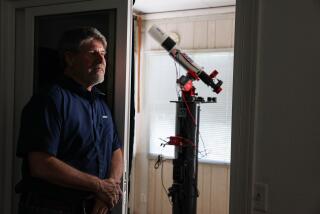Astronomical : * Stargazers: ‘It’s a fad, a lovely fad,’ Griffith Observatory Director Ed Krupp says of the public’s intense interest in today’s solar eclipse.
Barbara Crain, 37, moved to Saugus four years ago from the San Fernando Valley and became an astronomy buff overnight.
“I took one look at the sky--it was so much darker--I went out and bought a telescope, signed up for an astronomy club,” she said. “Now I can’t get enough of it.”
On evenings with a new moon, astronomy clubs and classes gather in the mountains--at Mt. Pinos near Frazier Park, in Saugus, Ventura, Moorpark, Pyramid Lake--to stargaze through each other’s telescopes and compare notes. Interest in things celestial is growing steadily, as astronomy buffs invest in high-tech telescopes that can cost from $500 to $10,000 and wow each other with well-focused views of the universe. Says Crain, “It’s nice to point up to the sky and say to a friend, ‘There’s a globular cluster.’ ”
Sales at telescope stores are soaring. At Scope City, which has seven stores including ones in Sherman Oaks and Simi Valley, sales have risen 25% a year for the last 10 years, said Karl Morison, vice president for operations. Baby boomers, he said, watched the Sputnik from their dinner tables--or high chairs--and now are stimulated by public television shows such as “The Astronomers,” by space shuttle landings and by sky events such as today’s solar eclipse. “I’m always a bit amazed at the public’s knowledge, at the number who follow space,” he said.
Today’s eclipse, which can be seen from 10:12 a.m. to 12:47 p.m., has generated a significant amount of interest during the last few weeks, said Ed Krupp, Ph.D., astronomer and director of the Griffith Observatory. The number of visitors to the observatory has grown steadily--1.9 million in 1990, up from a steady 1.5 million each of the previous five years. Within the past month, the eclipse has spurred more than 1,500 phone calls a week.
“It’s a fad, a lovely fad,” he said, adding that more people will travel to see this eclipse--to Hawaii and Mexico, which are the best locations to see it in its totality--than to view any other in history.
“Something like an eclipse--and this is the mother of all eclipses--crystallizes the high level of interest in astronomy in a very temporary way,” Krupp said. “But there has been an amazing increase in interest in general astronomy over the last few years.”
The observatory plans to open its gates at 9 this morning. Officials suggest that people arrive early because the road to the facility will be closed as soon as the parking lots are full. Solar telescopes will be set up all over the grounds so visitors can safely view the eclipse, or they can see it magnified, live, on the side of the facility. Safe solar filters will be available for sale, at $4.95, and astronomers will be on duty to explain the event. The observatory also plans a special show on the eclipse called “Moon Shadows” at 3 and 7 p.m. today.
Jim Mahon, 35, of Canoga Park is president of The Local Group, an eight-year-old, 65-member astronomy club. The club, whose name refers to the group of galaxies that includes the Milky Way, holds monthly star parties--a term for group stargazing--and has regularly scheduled talks at Placerita Nature Center in Newhall. The club also runs a star watchers’ class every other month for newcomers.
“You don’t have to be a rocket scientist,” Mahon said, “but a club tends to stretch you a little bit, to expand your knowledge.” Mahon, a manufacturing department manager at Rocketdyne in Canoga Park, bought his first telescope to see Halley’s Comet in 1986. “And now I’m off the deep end,” he said.
All it takes to get interested, he said, is to look through someone’s telescope and see something really beautiful or amazing.
“Seeing Saturn will do it for you--it looks just like a toy--or if you can have one big moment of revelation when you’re all of a sudden aware you’re on this ball, Earth, and it almost feels as though you’re moving,” Mahon said.
Many potential members come to a star party by accident--they’re out driving on a Saturday night in the mountains or they are camping and see a group of people looking at the sky through telescopes, Mahon said.
“A quarter of the people who go up to Mt. Pinos to a star party end up hooked. It can be very intimidating when you start out, but once you get going, you never finish,” he said. The level of interest varies from member to member, ranging from those who like to sketch what they see, to those who just like to sweep the Milky Way through their binoculars, to those who like to lie down on a chaise longue and look for meteors. Others come for the margaritas that the group tends to drink while stargazing.
For Larry Cotter, 64, of Sylmar the real pleasure in astronomy now comes from sharing the science with others. He finds his eight-inch, $2,500 Schmidt-Cassegrain scope boring. “It has shown me just about everything it can,” he said. Now he talks to children about astronomy. Last year he shared his love of the night sky with students at about two dozen schools.
Tim Thompson, 41, of Duarte is president of the Los Angeles Astronomical Society, which has almost 350 members, primarily in Los Angeles County. The club owns property in Ventura County’s Lockwood Valley, where members hold a monthly new-moon star party and roll out a 31-inch aperture Newtonian telescope, which Thompson says is believed to be the largest telescope owned by any amateur astronomy group.
Thompson, a data analyst at Jet Propulsion Laboratory in Pasadena, said the intensity of interest in astronomy--as well as each person’s stargazing style--varies among the members in this club.
“Some want to set up their telescopes and talk to everyone, some go to the star party to see one particular thing, and others want to see everything they possibly can in a given night.”
But Thompson finds one thing is universal: Most people can’t walk by a telescope without peeking. “All you have to do is go somewhere and set up a telescope and people will crowd around and ask, ‘What are you looking at? Can I look?’ ” he said.
Some of the interest in astronomy, Thompson said, is spawned in college astronomy classes, which people often take to fulfill a general science requirement. Some amateur astronomers are frustrated would-be scientists or astronauts; others are fascinated by new-age philosophy and the mystical potential of contemplating the galaxies.
Many local astronomy club members have traveled to Mexico or Hawaii to see the total eclipse on cruises and tour packages designed for the eclipse-crazed. Crain and her husband, Earl, 39, booked a $2,700 cruise from San Diego to La Paz and arranged child care for their two children, 6 and 3, just to make sure that they would catch the seven minutes of midday darkness off the coast of Mexico. Jim Mahon is taking his girlfriend, Diane Banbury, to the Kona Coast of Hawaii and said he’s planning to propose to her during the eclipse.
Some businesses seem to be prospering from the solar sizzle. Adrian Herzog, professor of physics and astronomy at CSUN, said there are scores of solar eclipse T-shirts and mugs selling in Hawaii and by mail order. Bill Rollo, of Roger W. Tuthill in New York, said the firm, which sells $1 to $150 sun filters for cameras, binoculars, telescopes and video cameras, and markets special card-mounted viewers for watching the eclipse, was getting more than 10 orders an hour in June.
“We’ve got all the business we can handle, and we’re not even supposed to answer the phone,” he said.
CSUN’s Herzog, who grew up talking about stars because his father was a Caltech astronomy professor, said he is amazed that a celestial event can create such massive interest in astronomy. He does understand personal fascination with the sky, however.
“It’s a nice hobby; you can go out camping, take your telescope and your family and see some real interesting things,” he said.
While many find astronomy clubs a good way to learn about the sky and become more skilled at using their telescopes, others prefer to go it alone. Dick Smith, 44, a Van Nuys plumber, found his junior-high interest in astronomy reactivated when he saw his friend’s 10-inch scope one evening at a family-organized star party.
While he hasn’t purchased a telescope yet, Smith bought Atari planetarium software that allows him to study more than 10,000 sky objects on his home computer.
“I can stand anywhere on Earth and get a sky picture from 10,000 years past to 10,000 years forward,” he said. Smith plans to watch the eclipse on his computer screen.
For Mahon, astronomy helps keep the big picture in focus: “For me, it’s real good at putting things in perspective. If I’ve had a hard week, I can realize real quickly that I’m part of the whole universe.”
The Local Group holds monthly star parties and offers classes for newcomers. Annual dues: $15. Jim Mahon, president. (818) 772-7343 or (805) 259-3284. The Los Angeles Astronomical Society holds monthly star parties on society-owned property and conducts classes on a variety of topics. Dues: $25 a year plus $10 initiation fee. Tim Thompson, president. (213) 833-1733.
Gray is a regular contributor to Valley View.
More to Read
Sign up for The Wild
We’ll help you find the best places to hike, bike and run, as well as the perfect silent spots for meditation and yoga.
You may occasionally receive promotional content from the Los Angeles Times.






